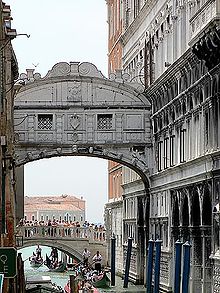Bridge of Sighs
![]()
The title of this article is ambiguous. For other meanings, see Bridge of Sighs (disambiguation).
![]()
This article or subsequent section is not sufficiently supported by evidence (e.g., anecdotal evidence). Information without sufficient evidence may be removed in the near future. Please help Wikipedia by researching the information and adding good supporting evidence.
The Bridge of Sighs (Italian: Ponte dei Sospiri) is a building connecting the Doge's Palace and the Prigioni nuove, the new prison, in the Italian city of Venice, crossing the Rio di Palazzo, a canal about eight metres wide.
The narrow, eleven-metre-long, white limestone bridge was planned by Antonio Contin, a nephew of Antonio da Ponte, the builder of the Rialto Bridge. Construction began in 1600 and was completed in 1602/03. Contin had also worked on the Rialto Bridge. From the Doge's Palace, those sentenced by Venetian courts to imprisonment or execution were led across this bridge to the prison rooms. Two paths, separated by a wall, lead across the bridge, preventing the prisoners being led away from seeing those being brought before the court.
The "Bridge of Sighs" only received its name in the age of Romanticism, in the idea that prisoners on their way to prison could take a look at the freedom of the lagoon from here for the last time with a sigh.
One has a very good view to the Bridge of Sighs from the Ponte della Paglia.
Many similar bridges were also named Bridge of Sighs after the Italian model. Better known among them are those at Cambridge University, Oxford University and Bremen.
The Bridge of Sighs (Le pont des soupirs) is also the name of an opera bouffon by Jacques Offenbach.
45.433958333312.3408944444Coordinates: 45° 26′ 2.2″ N, 12° 20′ 27.2″ E

View of the Bridge of Sighs, the Rio di Palazzo and the Ponte della Paglia; on the left the Prigioni nuove
.jpg)
View from the other side
See also
- List of bridges in Venice
Questions and Answers
Q: Where is the Bridge of Sighs located?
A: The Bridge of Sighs is located in Venice, northern Italy.
Q: What is the Bridge of Sighs made of?
A: The Bridge of Sighs is made of white limestone and has windows with stone bars.
Q: What is the purpose of the Bridge of Sighs?
A: The Bridge of Sighs connects the old prisons to the interrogation rooms in the Doge's Palace.
Q: When was the Bridge of Sighs built?
A: The Bridge of Sighs was built in 1602.
Q: Why was the Bridge of Sighs named as such?
A: The Bridge of Sighs was named by Lord Byron in the 19th century as it was thought that prisoners would sigh at their final view of beautiful Venice through the windows before being taken down to their cells.
Q: Were major criminals held in the cells under the Doge's Palace?
A: No, the cells under the Doge's Palace were occupied mostly by small-time criminals.
Q: Is there a local legend related to the Bridge of Sighs?
A: Yes, a local legend says that lovers will be granted everlasting love and bliss if they kiss on a gondola at sunset under the bridge.
Search within the encyclopedia